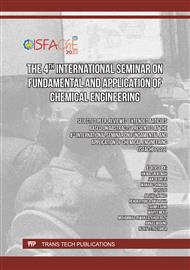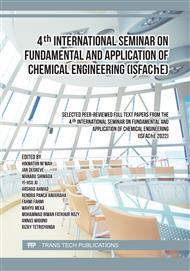[1]
Suwahyono, U. (2013). Membuat Biopestisida. Jakarta: Penebar Swadaya.
Google Scholar
[2]
Nurhatika, S. (1990). Pestisida. Surabaya: Institut Teknologi Sepuluh Nopember.
DOI: 10.35912/jpu.v2i1.1726
Google Scholar
[3]
Phillips, M. (2014). The Biological Pesticide Market. Agrolook, 1-4.
Google Scholar
[4]
Komisi Agens Hayati. (2006). Pedoman Pengajuan Pemasukan Agens Hayati ke Wilayah Negara Kesatuan Republik Indonesia. Keputusan Ketua Komisi Agens Hayati Kementrian Pertanian Nomor 226/Kpts/OT.160/L/9/06.
DOI: 10.14692/jfi.10.5.160
Google Scholar
[5]
Supriadi dan Suharto. (2008). Bioetika penggunaan agens hayati untuk pengendalian hama dan penyakit tanaman. Dalam M. Machmud, Bambang Setiadi dan Sutrisno. Tinjauan Bioetika Menuju Pertanian Berkelanjutan yang Selaras dengan Alam. (pp.94-100). Prosiding Seminar Nasional Bioetika Pertanian, 29 Mei 2008, Badan Penelitian dan Pengembangam Pertanian bekerjasama dengan Kedeputian Bidang Dinamika Masyarakat Kementerian Negara Riset dan Teknologi; dan Komisi Bioetika Nasional.
DOI: 10.29244/agro-maritim.050315
Google Scholar
[6]
Djunaedy, A. (2009). Biopestisida Sebagai Pengendali Organisme Pengganggu Tanaman (OPT) yang Ramah Lingkungan. EMBRYO Vol 6 No 1.
Google Scholar
[7]
Marwoto, & Suharsono. (2008). Strategi dan Komponen Teknologi Pengendalian Ulat.
Google Scholar
[8]
Laoh, JH, Puspita, & Hendra. (2003). Kerentanan larva Spodoptera litura F. terhadap virus nuklear polyhedrosis. Jurusan Agronomi Fakultas Pertanian Universitas Riau, Pekan Baru, Riau. Jurnal Natur Indonesia (2), 145-151.
DOI: 10.24961/j.tek.ind.pert.2018.28.2.210
Google Scholar
[9]
Razak, TA, T santhakumar, K megaswari, & S santhi. (2014). Studies on efficacy of certain neem products against Spodoptera litura (Fab.). Jurnal Biopest, 160-163.
Google Scholar
[10]
Suharsono, & Muchlish, M. (2010). Identifikasi Sumber Ketahanan Aksesi Plasma Nutfah Kedelai Untuk Ulat Grayak Spodoptera litura F. Malang: Balai Penelitian Tanaman Kacang-Kacangan dan Umbi-Umbian.
DOI: 10.21082/blpn.v16n1.2010.p29-37
Google Scholar
[11]
Krishanti, N. R., Wikantyoso, B., Zulfitri, A., & Zulfiana, D. (2017). Bakteri Entomopatogen Sebagai Agen Biokontrol Terhadap Larva Spodoptera litura (F.) . Berita Biologi, 16.
DOI: 10.14203/beritabiologi.v16i1.2153
Google Scholar
[12]
Onifade, A., & Agboola, K. (2003). Effect of Fungal Infection Proximate Nutrient Composition of Coconut Agriculture and Environment.
Google Scholar
[13]
Pambayun, R. (2002). Teknologi Pengolahan Nata De Coco. Yogyakarta: Kanisius.
Google Scholar
[14]
Burgers, H., & Jones, K. (1998). Formulation of Microbial Biopesticides: Beneficial Microorganisms, Nemathodes, and Seed Treatments. Dordrecht, Netherlands. 127 pp: Kluwer Academic Publisher.
Google Scholar
[15]
Gazali, A., Ilhamiyah, & Jaelani, A. (2017). Bacillus Thrungiensis. Banjarmasin: Pustaka Buana.
Google Scholar
[16]
Helgason, E., Okstad, O., Caugant, D., & et al. (2000). Genetic Structure of population of Bacillus cereus and Bacillus Thuringiensis isolate Associated with Periodontitis and other Human Infections. Jurnal of Clinical Microbiology, 38:1615-1622.
DOI: 10.1128/jcm.38.4.1615-1622.2000
Google Scholar
[17]
Tojo, A. (1986). Mode of Action Bipiramidal Delta-endotoksin of Bacillus thuringiensis subs. Kurstaki HD-1. Applied and Environmental Microbiology, 51(3):630-633.
DOI: 10.1128/aem.51.3.630-633.1986
Google Scholar
[18]
Khetan, S. K. (2001). Microbial Pest Control.
Google Scholar
[19]
Dini, Y. (2005). Profil Protein Kristal dan DNA Genom Total Galur Bakteri Bacillus Thuringiensis. Universitas Pakuan Bogor: Fakultas MIPA .
Google Scholar
[20]
CFSAN. (2001). Bacillus cereus and other Bacillus spp. In: Foodborne Pathogenic Microorganisms and Natural Toxins Handbook. Washington: FDA.
Google Scholar
[21]
Kramer, & R.J, G. (1989). Bacillus cereus and other Bacillus species, Food Bacterial Pathogens ed. Doyle. New York: Marcel Dekker.
Google Scholar
[22]
Giffel, M., Beumer, R., Slaghius, & Rombouts, F. (1995). Occurrence and characterization of (psychrotrophic) Bacillus cereus on farms in the Netherlands. Milk DIary J, 49, 125-138.
Google Scholar
[23]
Bradbury, J. (1986). Guide to Plant Pathogenic Bacteria. Ferry Lane, Kew Surrey, England: CAB International.
Google Scholar
[24]
Ahmad, R. Z. (2008). Lethal Time 50 Cendawan Beauveria bassiana dan Metarhizium Anisopliae terhadap Sarcoptes Scaibiei. Balai Besar Penelitian Veteriner.
Google Scholar
[25]
Priyanto. (2010). Toksikologi Ed:2. Depok: Leskonfi Lembaga Studi dan Konsultasi Farmakologi.
Google Scholar
[26]
Mayaserli, D., & Renowati. (2015). Pemanfaatan Air Kelapa Tua Sebagai Media Pertumbuhan Peudomonas Flueresencens dan Aplikasi Sebagai Pupuk Cair Tanaman. 19-22.
Google Scholar
[27]
Bravo, A., Gill, S., & Soberon, M. (2007). Mode of action of Bacillus thuringiensis Cry and Cyt toxins and their potential for insect control. Toxicon 49(4), 423-435.
DOI: 10.1016/j.toxicon.2006.11.022
Google Scholar
[28]
Thuleckle. (1961). Coconuts. London: Longmans Green and Co.
Google Scholar
[29]
Radji, M. (2011). Mikrobiologi; Panduan Mahasiswa Farmasi dan Kedokteran. Jakarta: EGC.
Google Scholar
[30]
Hanudin, Nuryani, W., Yusuf, E., & Marwoto, B. (2011). Biopestisida Organik Berbahan Aktif Bacillus subtilis dan Pseudomonas fluorescens untuk Mengendalikan Penyakit Layu Fusarium pada Anyelir. J. Hort. 21(2), 152-163.
DOI: 10.21082/jhort.v21n2.2011.p152-163
Google Scholar
[31]
Suriani, S., Soemarno, & Suharjono. (2013). Pengaruh Suhu dan pH terhadap Laju pertumbuhan Lima Isolat Bakteri Anggota Genus Pseudomonas yang diisolasi dari Ekosistem Sungai Tercemar Deterjen di sekitar Kampus Universitas Brawijaya. J-PAL, Vol. 3, No. 2,, 58-62.
Google Scholar
[32]
Bahagiawati. (2002). Penggunaan Bacillus Thuringiensis sebagai Bioinsektsida. Buletin Argobio Vol 5 No 1, 21-28.
Google Scholar
[33]
Dulmage, H. T., & Rodhes, R. A. (1971). Production of Phatogens in Artificial Media.
Google Scholar
[34]
Vandekar, M., & Dulmage, H. T. (1982). Guidelines for Production Bacillus thuringiensis. Fermentation and Enzyme Technology.
Google Scholar
[35]
Yulensri, Noveri, & Arneti. (2018). Pengembangan Bakteri Pelarut Fosfat, Pengikat Nitrogen, Agens Hayati Asal Mikroorganisme Lokal Sebagai Biofertilizer dan Biopestisida untuk Meningkatkan Produktivitas Hasil Padi di Lahan Organik.
Google Scholar
[36]
Bailey, M. J., & Lilley, A. K. (2006). Microbial Ecology of Aerial Plant Surface.
Google Scholar
[37]
Soesanto, L. (2004). Kemampuan Pseudomonas fluorescens P60 Sebagai Agensia Pengendali Hayati Penyakit Busuk Batang Kacang Tanah In Vivo. Eugenia 10, 8-17.
DOI: 10.35791/eug.17.2.2011.4105
Google Scholar
[38]
Ciptawati, E., Dzikrulloh, M. H., Septiani, M. O., Rinata, V., Rokhim, D. A., Fauziyyah, N. A., & Sribuana, D. (2022). Analisis Kandungan Mineral dari Lumpur Panas Sidoarjo sebagai Potensi Sumber Silika dan Arah Pemanfaatannya. Indonesian Journal of Chemical Analysis.
DOI: 10.20885/ijca.vol5.iss1.art3
Google Scholar
[39]
Lewis, K. (2001). Riddle of Biofilm Resistance. Antimicrob Agents Chemother, 999-1007.
DOI: 10.1128/aac.45.4.999-1007.2001
Google Scholar
[40]
Semangun, H. (2001). Penyakit-Penyakit Tanaman Pangan di Indonesia. Yogyakarta: UGM Press.
Google Scholar
[41]
Santosa, D. (2008). Isolat Bakteri Luapan Lumpur Lapindo dan Analisa Dampak Kesehatan. Malang.
Google Scholar
[42]
Salaki, C. L., & Dantje, T. (2018). Prospek Pemanfaatan Biopestisida Bakteri Entomopatogenik Isolat Lokal Sebagai Agen Pengendali Hayati Hama Tanaman Sayuran. Eugenia, 102.
DOI: 10.35791/eug.19.1.2013.8375
Google Scholar
[43]
Krishanti, N. R., Wikantyoso, B., Zulfitri, A., & Zulfiana, D. (2017). Bakteri Entomopatogen Sebagai Agen Biokontrol Terhadap Larva Spodoptera litura (F.) . Berita Biologi, 16.
DOI: 10.14203/beritabiologi.v16i1.2153
Google Scholar
[44]
Jusuf, E. (2009). Exploration of Bacillus thuringiensis d-endotoksin Protein Distributed Around Jabodetabek Region. Microbiology Indonesia, 51-55.
DOI: 10.5454/mi.3.2.1
Google Scholar
[45]
Hofte, H., & Whiteley, H. R. (1989). Insecticydal Crystal Protein of Bacillus thuringiensis. Microbiology.
Google Scholar
[46]
Crickmore, N., Zeigler, D. R., & Feitelson, J. (1998). Revision of the Nomenclature for the Bacillus thuringiensis Pesticidal Crystal Proteins. Microbiology and Molecular Biology, 807–813.
DOI: 10.1128/mmbr.62.3.807-813.1998
Google Scholar
[47]
Schunemann, R., Knaak, N., & Fluza, L. M. (2014). Mode of Action and Specifity of Bacillus thuringiensis Toxins in the Control of Caterpillars and Stink Bugs in Soybean Culture. ISRN Microbiology, 1-12.
DOI: 10.1155/2014/135675
Google Scholar
[48]
Matsumoto, K. S. (2006). Fungal Chitinases. Advanced in Agricultural and Food Biotechnology, 289-304.
Google Scholar
[49]
Gilbert, G. I., Iatrou, K., & Gill, S. S. (2005). Biochemistry of Digestion, in: Comprehensive Molecular Insect Science Biochemical and Molecular Biology. Oxford, UK: Elsevier Press.
Google Scholar
[50]
Fan, Y. H., Fang, W. G., Pei, X. Q., Zhang, Y. G., Xiao, Y. H., Bidochka, M. J., & Pei, Y. (2007). Increased Insect Virulence in Beauveria bassiana Strains Over Expressing an Engineered Chitinase. Applied Environmental Microbiology, 295-302.
DOI: 10.1128/aem.01974-06
Google Scholar



